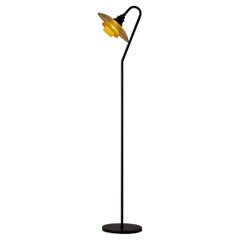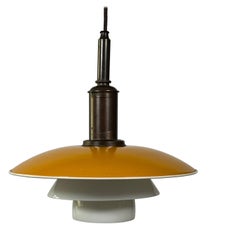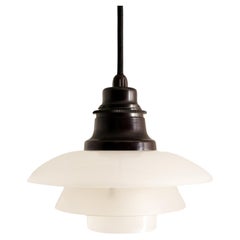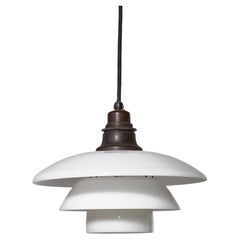Poul Henningsen Furniture
The name Poul Henningsen is synonymous with the best and most innovative modern Scandinavian lamps and other lighting. The Danish designer created a signature vocabulary of fixtures with tiered and layered shades in sculptural arrangements that are at once naturalistic and geometric.
Henningsen grew up in a town on the outskirts of Copenhagen and studied architecture at the Technical University of Denmark. He would become a noted art critic, journalist and screenwriter, but his first love was lighting design.
Henningsen’s childhood home was illuminated by oil lamps. When his family switched to electrified lighting, he was alarmed and repelled by the harsh glare cast by an incandescent bulb, and in his late teens he began conducting quasi-scientific experiments to measure which materials and methods best diffused or reflected light to give it a warm brightness. His work came to the attention of the lighting-fixtures firm Louis Poulsen, which sponsored the development of a prototype lamp. The design won a gold medal at the 1925 Paris Expositions Internationales des Arts Decóratifs et Industriels Modernes — from which the term Art Deco derives. The lamp, whose three-part shade is said to be inspired by the arrangement of a dinner plate atop a soup bowl atop a teacup, became the basis for Henningsen’s most successful design, the PH 4/3 desk lamp.
All told, Henningsen would design some 100 lighting fixtures in his career. Some of his most notable creations are hanging lamps, which include the Septima (1929), a pendant composed of seven graduated frosted-glass layers; the Spiral (1942), made of a single ribbon of enameled aluminum; and the Artichoke lamp (1958), whose 70 glass or metal fins in a staggered and graduated arrangement on a central steel frame resemble those of its namesake. The last is likely Henningsen’s masterwork and an icon of mid-20th-century design. Like all Henningsen lighting designs, it is striking, sculptural and — thanks to his insistence on the primacy of the quality of the light cast — superbly functional.
Find a collection of authentic Poul Henningsen table lamps, floor lamps and other lighting on 1stDibs.
1930s Danish Mid-Century Modern Vintage Poul Henningsen Furniture
Metal, Steel
1930s Danish Scandinavian Modern Vintage Poul Henningsen Furniture
Brass
1930s Danish Scandinavian Modern Vintage Poul Henningsen Furniture
Metal
1930s Danish Scandinavian Modern Vintage Poul Henningsen Furniture
Brass
1930s Danish Scandinavian Modern Vintage Poul Henningsen Furniture
Glass, Bakelite
1930s Danish Scandinavian Modern Vintage Poul Henningsen Furniture
Brass
1930s Danish Scandinavian Modern Vintage Poul Henningsen Furniture
Brass
1930s Danish Scandinavian Modern Vintage Poul Henningsen Furniture
Brass
1930s Danish Scandinavian Modern Vintage Poul Henningsen Furniture
Brass, Copper, Nickel
1930s Danish Scandinavian Modern Vintage Poul Henningsen Furniture
Brass
1930s Danish Scandinavian Modern Vintage Poul Henningsen Furniture
Metal, Brass
1930s Danish Scandinavian Modern Vintage Poul Henningsen Furniture
Brass
1930s Danish Scandinavian Modern Vintage Poul Henningsen Furniture
Stainless Steel
1930s Danish Scandinavian Modern Vintage Poul Henningsen Furniture
Chrome
1930s Danish Scandinavian Modern Vintage Poul Henningsen Furniture
Brass
1930s Danish Scandinavian Modern Vintage Poul Henningsen Furniture
Metal
1930s Danish Scandinavian Modern Vintage Poul Henningsen Furniture
Brass, Copper
1930s Danish Scandinavian Modern Vintage Poul Henningsen Furniture
Chrome
1930s Danish Scandinavian Modern Vintage Poul Henningsen Furniture
Metal
1930s Danish Mid-Century Modern Vintage Poul Henningsen Furniture
Metal
1930s Danish Scandinavian Modern Vintage Poul Henningsen Furniture
Opaline Glass
1930s Danish Scandinavian Modern Vintage Poul Henningsen Furniture
Metal
1930s Danish Mid-Century Modern Vintage Poul Henningsen Furniture
Brass
1930s Danish Scandinavian Modern Vintage Poul Henningsen Furniture
Brass
1930s Danish Scandinavian Modern Vintage Poul Henningsen Furniture
Brass
1930s Danish Scandinavian Modern Vintage Poul Henningsen Furniture
Brass
1930s Danish Scandinavian Modern Vintage Poul Henningsen Furniture
Brass
1930s Danish Scandinavian Modern Vintage Poul Henningsen Furniture
Brass
1930s Danish Scandinavian Modern Vintage Poul Henningsen Furniture
Brass
1930s Danish Bauhaus Vintage Poul Henningsen Furniture
Zinc, Brass
1930s Danish Vintage Poul Henningsen Furniture
Brass
1930s Danish Scandinavian Modern Vintage Poul Henningsen Furniture
Brass
Poul Henningsen furniture for sale on 1stDibs.
Creators Similar to Poul Henningsen
- 1stDibs ExpertFebruary 13, 2024Poul Henningsen is famous for designing innovative modern Scandinavian lamps and other lighting. The Danish designer created a signature vocabulary of fixtures with tiered and layered shades in sculptural arrangements that are at once naturalistic and geometric. Some of his most iconic pieces include the Spiral, made of a single ribbon of enameled aluminum, and the Artichoke lamp, whose 70 glass or metal fins in a staggered and graduated arrangement on a central steel frame resemble those of its namesake. Find a collection of Poul Henningsen lighting on 1stDibs.





